Zcar Turbo Information

Intro
This page has been compiled from internet sources, especially
from posts on zcar.com thanks to all! It is presently a work in progress
and at this point, it simply is a lot of cut and pasted info. I am in the
process of streamlining the presentation.
Newbie
Turbo Info is here. It is highly recommended that you read it first before
continuing
Turbocharger
- A stock '82 280ZXT has Garrett Air Research T3 Turbo
(60 comp trim and .63 turbine trim) installed.
- A common upgrade is to go with a Garrett T3/T04 Hybrid unit.
- Details
and specs for a T3 are further down near the bottom of the page.

Basic air flow through a turbo. Intake
is blue and exhaust is red
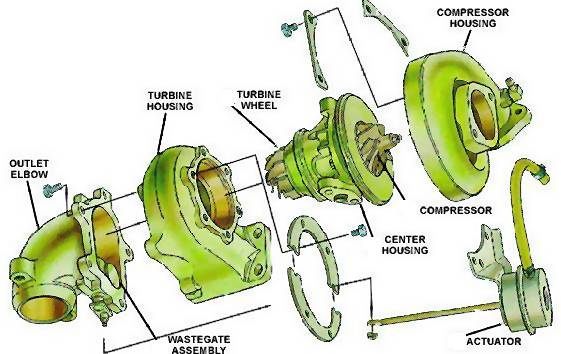
Exploded view of a generic turbo
Fuel
-
Since a turbo adds more air, the fuel injection system must also add more fuel. Two common ways to do
this are to increase injector flow or to increase fuel pressure. Increasing
injector size by swapping out the stock with higher flow injectors is the more
common route. When doing so, the fuel to air metering system (part of EFI
system) must be recalibrated for the new injectors to prevent a lean or rich
burn.
- Stock 280zxt has 265cc/min or 25.2lbs/hr
injectors . (FYI Non-Turbo 280z has 185cc/min or 17.6lbs/hr injectors)
- Stock
injectors start to lean out at 10psi boost at nominal fuel pressure (engine
consumes 1761lbs air/hour (click
here to see calc) thus at 12:1 air/fuel ratio, 147 lbs-fuel/hour is
consumed. Dividing this among 6 injectors gives 24.5lbs/hr of fuel for each
injector.
- Here are some ball park injector sizes and HP
for an inline 6 turbo
| Engine HP |
RWHP |
cc/min |
lbs/hr |
| 200 |
160 |
268 |
26 |
| 250 |
200 |
335 |
32 |
| 300 |
240 |
402 |
38 |
| 350 |
280 |
468 |
45 |
| 400 |
320 |
535 |
51 |
Boost
Compression:
-
Standard compression with F54 w/dished pistions,
standard HG and P90 - 7.38:1
-
F54 w/dished, HKS 1MM and P90 - 7.52:1
- N/A engines typically have compression ratios
from 8.5 to 10.5
- Low compression AND inter-cooling AND timing
control all interact together to determine the high boost potential of a turbo motor. Regardless of
the motor being from a N/A with high compression or from turbo with low
compression, detonation occurs at a certain temperature and pressure.
Block Diagrams:
Stock 280zxt airflow diagram

L28ET Air Flow (click to expand)
Modified 280zxt airflow diagram

Typically modified 280zxt turbo flow/part diagram (click to expand)
Overview of air flow in the above diagram
- Exhaust
air spins the turbine
- Air is sucked into intake (due to
spinning compressor and piston suction on down stroke).
- Air flows through the AFM and its flap moves
proportionally. The AFM sends a signal to the "computer" to tell
how much air is entering the engine and the "computer" tries to add
enough fuel via the injectors to maintain an approximate 15:1 air to fuel
mixture.
- Air passes through the turbo's compressor
section where it is compressed. The process of compressing heats the air
(talk to Sadi Carnot). The amount of compression is called "boost"
and is usually measured in PSI however a BAR is often used. 1Bar = 14.7PSI
which is the average atmospheric pressure at sea level.
- The hot compressed air flows internally
through the intercooler. Wind from the car's motion passes externally over
the intercooler and carries away heat. Thus the internal pressurized air is
cooled.
- The cool pressurized air passes over the
throttle body, through the manifold and into the combustion chamber via the
intake port.
- The cool pressurized air is mixed with
injected gas upon entering, compressed by the piston, then ignited by the
sparkplug.
- The expanding gas from the explosion pushes
the piston down then exits via the exhaust port.
- The exhaust gas passes through the turbo's
turbine, spins it and starts the cycle again.
Overview of feedback and protection
devices/functions in
the above diagram
- The waste gate is a door to allow exhaust air
to bypass the turbine. It is opened and closed to modulate how much exhaust
gas flows over the turbine and in turn modulates how fast the turbine spins
the compressor which, in turn, controls how much pressure is built up in the
manifold in area "A". Too much pressurized air entering the
combustion chamber can cause premature detonation as the piston compresses
the hot high pressurized air. So-called "detonation" can push the
piston backwards against the engine's momentum and destroy it. The waste
gate is mechanically opened and closed by the waste gate actuator.
- The boost controller modulates the waste gate actuator. The input line (lime green colour) to the boost controller can be
connected to monitor the pressure at "A" in the manifold (as
shown) or alternately to monitor the pressure at "B" at the outlet
of the compressor. The boost controller is set to limit the maximum boost
pressure. For a stock ZXT the boost controller's set point is fixed at ~6psi
but for an intercooled zxt it is typically set to between 10 and 16psi.(more
boost means more power from the engine but also increases the risk of
detonation).
- The pop-off valve is simply an emergency
pressure release device to prevent over-boosted air from entering the
combustion chamber. It functions by venting the air to the engine
compartment when the pressure rises above the maximum boost threshold. For a
stock zxt with boost set at 6psi, the pop-off vents at ~9psi. For an
intercooled zxt with the boost controller's maximum boost set to 12psi, the
pop-off valve would be set to ~ 14psi. The pop-off valve can protect the
engine in the instance when the waste gate or waset gate actuator fails. If
this were to happen, boost levels could go well beyond 25psi without a
pop-off valve present.
- The blow-off valve is opened when the throttle
valve is abruptly shut to prevent back-pressure on the compressor.
In normal operation, air flows though the compressor then freely into the
engine, thus the pressure on each side of the open throttle valve in
"A" and "B" is nearly identical. However, immediately
after the TB valve is abruptly closed (foot off the gas pedal), the air flow
through the engine is nearly brought to a complete halt at the TB. Exhaust
air and self-momentum of the turbo wheels continues to spin the compressor.
The compressor then continues to pack air into the now sealed area
"B". The packing of air rapidly increases the pressure in
"B". This high pressure air in "B" causes backpressure
on the compressor and slows it down. (a bad thing for performance and it
also causes an unusual strain on the compressor). Since the blow-off valve
is monitoring the pressure in "A" (lime green colour), it can tell
when the pressure in "B" is different from that in "A".
If this pressure differential is too high, the blow-off valve will open and
allow the high pressure air in "B" to vent back in "C".
This equalizes the pressure on each side of the compressor thus it spins
freely and does not suffer the back pressure problems.
A common mistake is to vent the blow-off valve into the engine compartment
rather than re-circulating to the front of the compressor. By venting the
air that was "metered" by the AFM, the air to fuel mixture changes
and the engine runs rich.
Twin Turbo vs. Single on L28 engine:
- Twin (SEQUENTIAL) Turbo set-up. You have one smaller turbo
and one larger turbo. This is done to eliminate turbo lag. The smaller turbo
will spool up first, so it starts making boost, as you start making boost
and climbing higher into the power band you start making more exhaust, which
allows you spool up the larger turbo, making more boost and allowing better
exhaust flow while at the top end of the RPM range. Having two turbos doesn't
mean more power in a Sequential set-up. In fact the big dogs running Supras,
etc, are all running single turbos.
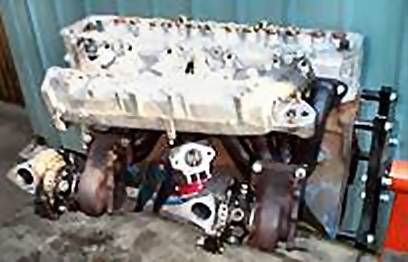
L28 with twin turbo


L28 with twin turbo

L28 with twin turbo (Twin Mitsubishi TDO5
16G's w/ 7cm housings) click
here for more info
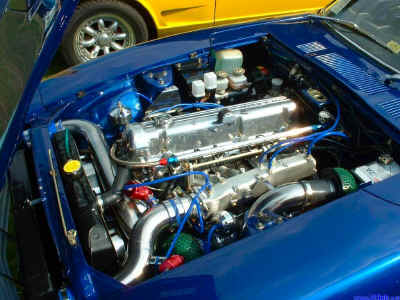
L26 260z with twin turbo (click on
picture to expand). click
here for more info
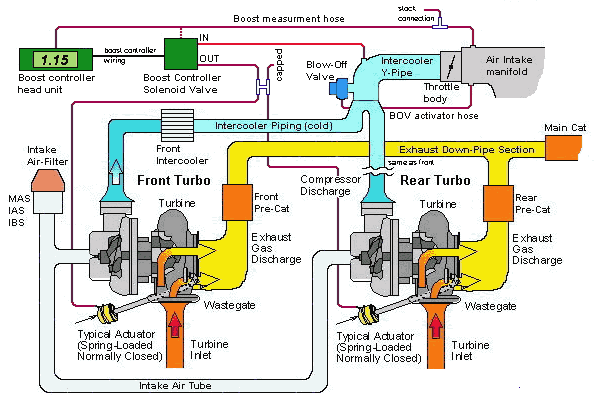
Block diagram for a Dodge Stealth Twin Turbo Set-up
Protection Devices:
The primary purpose of protection devices in the
turbo system is to prevent detonation. Detonation is caused by too much heat or
too much pressure (which causes heat) when the piston is compressing the intake
air during the engine's compression stroke. The combined heat from the turbocharged air AND the heat from the
compression stroke can ignite the gas in the cylinder prematurely. The resulting
early explosion pushes the piston in the reverse direction (against the rest of
the engine) which causes extremely high pressures on the piston, rod, crank arm,
rings, head gasket, valves. It is easy to understand the principal of
pressure causing detonation if you think of how a diesel engine works: The
diesel has no spark plug to ignite the fuel, the heat from the pressure does it!

red hot exhaust side of turbo
charger
- Intercooler
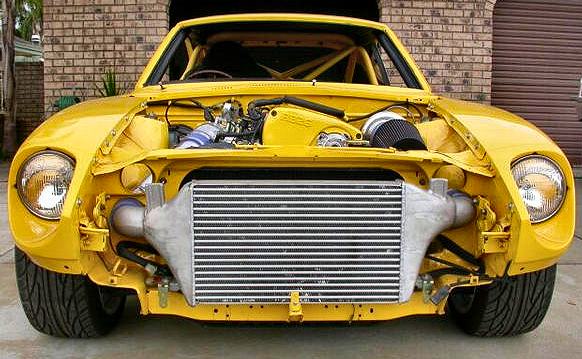
An intercooler cools the hot air coming out of the compressor and entering the
manifold.
When a turbocharger compresses (squeezes) air into your engine, it causes
the air to heat (to check this yourself, find a biker friend (Lance
Armstrong Type not Evil Knievel), and pump up his high-pressure road bike
tires using a frame pump ). Also, thermal coupling from the turbos's
exhaust side also heats up the intake side's air charge. The intercooler is
placed between the Turbocharger's output and the intake manifold. The bigger
the better and also the best flowing the better. Unfortunately 280zxt's do
not come with an intercooler. This limits the maximum boost (air pressure
increase due to compressed air) to ~ 10psi. Above this, detonation will
probably occur due to the extra heat. BTW the extra air also has extra
oxygen which also assists in the detonation (just like blowing on ambers to
re-ignite a camp fire). You can find out more on intercoolers in the how to
section.
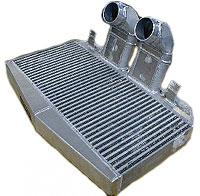
Typical Intercooler (input and output
ducts are for cooling the pressurized air charge flow from turbocharger)
What is the
purpose and/or advantage of an intercooler?
The purpose of the intercooler is to remove the
heat in the air charge that the turbo/supercharger puts into the charge when
compressing it. There are two advantages: Reducing the heat in the air
charge increases the charge density (more molecules of air per cubic foot),
thus increasing the potential for making more power. Reducing the heat
decreases the tendency of the combustion process to knock (detonation).
How does the intercooler affect the power output of
the engine?
Power is dependent on the density of the air charge. By decreasing
the temperature the intercooler increases air charge density, therefore, the
power is increased. Typically, the magnitude of the increase will be between
10 and 20% for the average (street) boost pressures.
Is some intercooling better than no intercooling?
No. It depends on the design of the intercooler, and there are two
factors involved; efficiency (how much heat is removed) and the flow
restriction (lost pressure) created by the presence of the intercooler.
Regardless of the efficiency, if too much pressure is lost, then the
intercooler is either useless or can actually decrease performance .
What are the differences between short tubes and long
tubes?
The longer the tube the greater the pressure loss accompanied by a
slight increase in efficiency
Does the length of the tube affect efficiency?
Very little. The most heat comes out of the tube where the
temperature difference between the inside and the outside is the greatest.
That exists in the first couple inches of the tube. The last inch of the
tube, wherein the charge temperature is rapidly approaching the cooling
media temperature, will transfer very little heat, thus being of minor use.
What factors affect efficiency of an Air-to-Air
Intercooler?
Frontal area: This is a rapidly decreasing function. If the proper
core size is used, then doubling it will definitely not double the
efficiency. More likely, doubling the core would raise the efficiency about
5% and cost twice the necessary amount and add substantially to the weight.
Plate area: Plate Area (the sum of the Core-Plate Area which is exposed to
the Atmosphere) is directly proportional to the frontal area and the
thickness. Thickness, however, is a double-edged sword. With the greater
thickness, the plate area increases but less ambient air can penetrate the
thicker core to offer cooling.
Ambient air quantity: It is very important to insure that air coming in the
snout of the car will actually go through the intercooler.
How does one measure the efficiency of the
intercooler?
The efficiency is defined as the ratio of the temperature removed
from the air charge by the intercooler relative to how much temperature is
put into the charge by the turbo/supercharger.
For example: If the turbo/supercharger puts 150 degrees F into the charge
when compressing the air, and the intercooler removes 110 of those degrees,
then the efficiency is:
Eff = 110 / 150 = .733, or 73.3%
What factors affect the pressure or flow loss?
The internal flow area is the major controlling factor. Tube length
is the second biggest consideration, as a tube twice as long as another will
have nearly twice the drag at the same air velocity. Tube entry and
turbulator density play small roles and can be considered insignificant.
When configuring the orientation of the core in a given space, always
position the core to offer the shortest length tube and the most number of
tubes. Clearly, this optimizes the internal flow area.
What ranges of pressure loss can be expected? And what is acceptable?
For good solid performance, the pressure loss across the
intercooler ought to be kept to less than 1.0 to 1.5 psi. If any pressure in
excess of 4 psi is measured, then the intercooler is not suited for the job
and certainly harming the performance.
If the boost is raised is it necessary to increase an
otherwise proper intercooler?
Very seldom. While the loss through the intercooler is proportional
to the flow (CFM) squared, unlikely the change will be of a magnitude that
requires a bigger intercooler. If dramatic changes in flow are created, say
50%, then the flow loss would increase by 1.5 squared, or 2.25, and that
would prove excessive thus strongly suggesting a larger intercooler.

Typical example of power gain from an
intercooler is sometimes an added bonus (~10% to 30%)
- Waste Gate

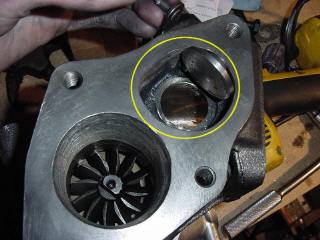
External Waste
Gate
Internal Waste Gate
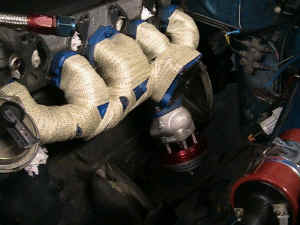
External Waste
Gate Installed
A waste gate is essentially a device that
bypasses some exhaust flow around the turbine section of a turbocharger to
control maximum boost. A waste gate is usually controlled by a pressure
actuator that is connected to manifold pressure. The waste gate is normally
closed, held shut by a spring inside the actuator canister. When preset
pressure limits are exceeded, the actuator progressively opens the waste gate,
allowing exhaust flow to bypass the turbine, thus regulating manifold boost
pressure. On the surface, it sounds like a simple premise, and in fact, a waste gate
is a simple device. The problem comes from the pressure in the
exhaust system, called turbine inlet pressure that can bear against the
valve, overpowering the spring in the actuator, and forcing the waste gate open at lower than intended boost levels.
Original equipment turbocharger waste gate actuators are selected or engineered for a specified boost level and turbine
inlet pressure. To keep costs down, such actuators are usually just big
enough to do the job at the stock boost levels. If the turbocharger boost is
increased for additional airflow and performance, the stock waste gate actuator is frequently incapable of holding the
waste gate fully closed until
the higher boost level is reached. This happens because turbine inlet
pressure also increases as boost pressure rises. The fix is to use a bigger
spring in the waste gate actuator to hold it closed until the desired peak
boost is achieved, however, that also requires a bigger actuator diaphragm
to override the heavier spring when the desired boost level is reached.
The net affect is that the turbocharger comes
up to peak boost more quickly and then maintains that boost level throughout
the engine’s RPM range for optimum mid-range torque and top end
performance.
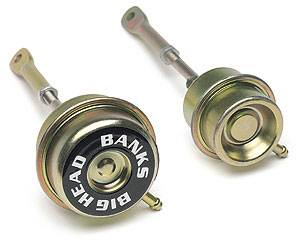
Mechanical Waste Gate Actuator
Waste Gate Controller AKA Boost Controller

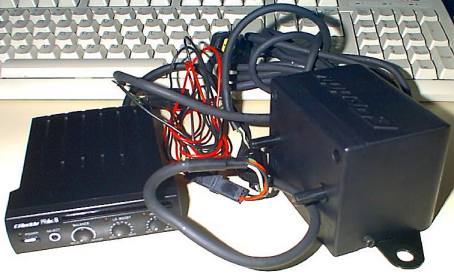
Mechanical Boost
Controller
Electronic Boost Controller (computer, hose, solenoid
valve)
The boost controller sets the pressure at
which the waste gate actuator operates. An electronic boost controller is
better at holding the waste gate shut and the level of boost can be
controlled from inside the car.
- Blow Off Valve (BOV) (Vacuum Control modulator
valve on 280zxt)
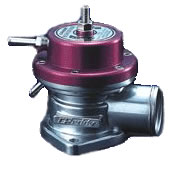
Blow Off Valve (BOV) (inlet is in
bottom, outlet is on right side)
Many factory turbo
installs have their BOV venting into a "Tube-inside-a-tube" so
that it's flow remains perfectly in-line and parallel to the inlet stream.
Remember, this thing doesn't just vent excess pressure, it's also flowing
sonic waves and pulses. It makes perfect sense to vent this straight back
into the turbo to help keep it spooled-up, instead of just wasting it by
venting that energy into the atmosphere
- Pressure Release Valve aka Pop Off Valve aka Emergency Relief Valve that is screwed into
the rear of the manifold TBD
This is basically just a backup BOV set to vent ~ 2 to 4psi above maximum
boost pressure
How to: (The basic mods and tips)
- Your first step to raising your boost is
getting a boost controller. This can be had for cheap if your not picky and
just want to raise boost. There are a few manual boost controllers out there
for around $50.00. I'm using TurboXS dual boost controller...that set me
back about $200.00. But when I first started playing with my motor, I
started out with a cheaper manual boost controller...I think one company is
Granger boost controller. You will also have to buy a boost gauge. The stock
one is useless when you raise your boost and getting a new gauge is the only
SAFE way you can see what your turbo is actually doing. I got my Autometer
boost gauge for about $45.00 on ebay.
- Get a boost controller, you can get a manual one for $35 at
www.dawesdevices.com

The turbo (OE & most aftermarket) have a provision for boost signal on
the compressor of the turbo that goes right to the waste gate. Your boost
controller goes inline with this, i.e.: the hose off the compressor housing
goes to the inlet on the boost controller and then the outlet of the boost
controller goes to the waste gate actuator inlet. Some systems with IC's can
run a boost signal in the IC piping. Last resort would be to use a signal
from the manifold (as you described). I say this because by time the boost
builds up and gets signal to the waste gate, you're probably over boosting
by several pounds. The only benefit is that waste gate creep is kept to a
minimum, but your set-up will have to be able to handle a slight over boost.
counter: If you are modifying your car you DON'T WANT the boost signal from
your compressor outlet. You want the boost signal from your INTAKE manifold.
TIP: ANY manual controller is best kept under the hood, with the lines as
short as possible.
TIP: The dual stage XS controller is
CHEAP compared to what you would pay for an electronic boost controller.
If you are not running boost high enough to cause serious traction problems,
stick with a single controller.
Using a two stage to allows the use 15~20psi for launching, and 30psi+ for
acceleration at speed in fourth and fifth gear...
Tip: Manual controllers works great. The only
disadvantage of the device compared to an electronic solenoid is that the
air vacuum takes longer to travel through all that hose causing potential
over-boost problems before the waste gate opens. Not a problem if your boost
gauge is accurate and you raise your boost slowly.

"Dial A
Boost" controller info on this page
DIY Manual Boost Controller
Use an air regulator valve from an air compressor. However a regular run of
the mill air regulator is not accurate enough to control low boost in small
increments. If you have the means, find a regulator that is super precise as
far as low pressure. A place called Mcmaster-Carr has them (almost like
Grainger units but better) Ranges are 0 to 20 psi out and 0 to 100 in
for $45.00. For running 10 psi, you can adjust from 3 to 5 psi over 3
full turns. Accuracy and precision are critical!
Electronic Boost Controller
For a stock ZXT, the boost is controlled by the waste gate actuator. It has a
~7psi spring in it holding the waste gate shut.....its also has a
diaphragm in it that's hooked to the intake manifold. So when you get to 7psi+
of pressure (boost) inside the intake the pressure behind the diaphragm is
greater than the 7lb spring holding the waste gate shut so it starts to open
up the waste gate...
An electronic boost controller it performs the same task, the same way; but
instead of just letting the intake manifold pressure do the actuator. it has a
valve between the intake and the actuator and it computes how much pressure
gets to the actuator after it has computed what would be best ......it
monitors a bunch of things going on in the engine and figures the best way to
do it (optimally). ...and costs you a lot of money.
- Get a boost gauge to see what your boost
controller is actually doing. (The stock one on ZX's is reported to be
inaccurate)

one bar = 14.7psi of boost
- Get an intercooler, you can get a used one off a starion or
others. Its what's going to help protect your engine. Intercooler
pics
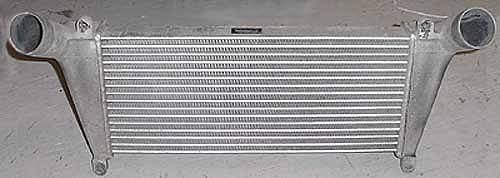
NPR Intercooler
GOOD CHOICES are. Isuzu NPR, Porsche 944, Toyota Supra, SVO Mustang,
Thunderbird SC
BAD CHOICES are, Volvo, Starion, Mitsubishi, some Audi's
- You can run up to about 10 psi with the stock T3, you will need a new boost
gauge and you need to either block off (not
recommended), modify, or replace your pop off valve with an aftermarket unit. Stock
injectors start to lean out at 10psi

Blow off valve location venting to
engine compartment (not efficient)

blow off valve
TIP: Surging the compressor sounds
like a dying goose right? It's because your compressor wheel is getting
slowed down real fast from real high rpm. Not good for your new turbo.
Get a BOV!
- The turbo from just about any Z31 300zxt will fit with no problems. It is a Garrett
T3 just like on the 280ZXT however the 300ZX t-3 is water cooled and the 280ZXT one in my
garage is not. (water cooled is better than
just hot oil).
- If you have a stock ZXT manifold, and are not
running some ridiculous pressures or flows, the stock BOV from the 280ZXT is
more than enough.
Even with an intercooler and the added volume, the stock unit works fine for
me up to around 12psi.
- '82 FSM gives the waste gate operating range as
41.9 - 47.2 kPa or 6.1 - 6.8 PSI and the relief valve operating range as
50.7 - 53.3 kPa or 7.4 - 7.7 PSI
- Well if you are planning on a significant
upgrade, then I would suggest a TO4E compressor side with a 50 trim, and a
stage 5 exhaust turbine wheel. That turbo will get you to 500hp.
Now here is the good part: You can run that turbo on a stock application,
what you will want to do is leave the waste gate actuator alone, so that the
turbo will maintain it's stock boost level of 7-8psi of boost. Use the stock
exhaust turbine housing and machine it for the stage5 exhaust turbine wheel.
Very realistic build, and when you start upgrading you will not need to mess
with the turbo. All you will need to do is get a boost controller and you
are in there.
- The 82-83 F54 blocks are the same for NA and
turbo cars. Crank and rods are also the same. The only major difference is
pistons: dished for turbo, flattop for NA. Both are cast aluminum. The ring
lands and grooves are the same thickness. The turbo piston has a slightly
higher pin height. Consequently, the higher compression ratio of the NA
block will not allow as much boost (non-intercooled). But with proper
intercooling and an efficient turbo, you can still turn up the boost, and
make tons of power. There are people doing it to NA blocks. Whatever block
you use, stock turbo injectors & ECU are limited to about ~270 crank HP.
The car with the higher static CR will be a little faster on the low end though. I
think the reason why converting an NA to turbo is discouraged is
because of the added complexity. It's just easier to start with a turbo
block, because all of the parts are there.

T3/04 Installed in L28 with mechanically
adjustable waste gate controller.
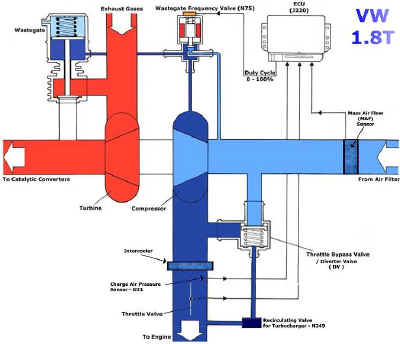
VW Turbo Block Diagram
BOV and POV Info
Stock 280zxt airflow diagram with
special items highlighted
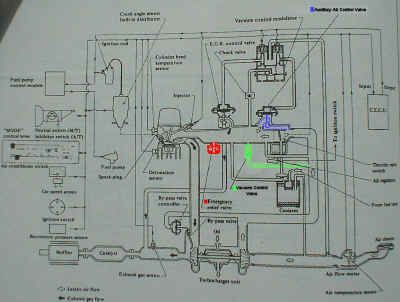
L28ET Air Flow (click to expand)
Emergency relief valve = Pop-Off Valve
Vacuum Control Valve + Auxillary Air Control Valve = "Pseudo" Blow Off
Valve
- A "blow off valve" and the
"pressure relief valve (also referred to as a "Pop Off Valve") are two
different things.
There is no stock BOV on the 280zxt, however there is a stock
pressure relief valve. If installing a BOV, it should go before the throttle.
- A pop-off valve. It's on the intake. The
BOV is typically aft of the intercooler but prior to the intake. The pop off
dumps all charge over a certain pressure and the bov dumps when the foot is
lifted on the accelerator.
A BOV installs on the i.c. piping or j-pipe
(close to the throttle body) and vents into the cold air plenum between the
afm and turbo.......depending on what valve you get, the install will be
different. some have flanges that have to be welded, some have a pipe w/a
fitting for the valve on it that's coupled into the j-pipe or i.c. piping .
mine is actuated by seeing vacuum in the intake.
- If you dont want to spend an arm and a leg for a blow off valve. find one
from a 1st gen eclipse.I have one that I will use. I hear that they can hold
up to 15lbs of boost fine and they are all metal.
- I'm using the Eagle Talon 1G BOV and it works as well as some high priced
aftermarket ones. If you look you can find one for around $25-50. They will
hold up to 22psi boost and more if they are modified. If you run the factory
ECU you will have to route the outlet back into your intake tract between the
AFM & turbo. This will quiet down even the noisiest BOV's. If your
running an aftermarket fuel injection system you can vent it to atmosphere
and make lots of noise.
- Under
vacuum, the BOV should lift and relieve pressure in the manifold before
the throttle plate to allow the compressor to keep spinning at high
spool-up speed allowing quick recovery into boost when the pedal is
depressed. It keeps the compressor section from going into stall under
static pressure. If you plumb the blow off line back into the inlet with a
pipe pointed straight at the impeller wheel, when it blows off, it actually
will pre-spin the turbo up to speed! Correct design routes the bov that way,
racer-boyz like the quiefe sound, so they vent it to atmosphere. Take a look
at where the Porsche turbos vent the blow off pressures...
The only time a BOV is giving you problems is when it lifts under boost,
when it doesn't seat and leaks boost, or doesn't open quick enough---causing
a boost spike in the intake tract possibly stalling or semi-surging the
compressor.
Vacuum-actuated units do act JUST like you describe when functioning
properly---it is also referred to as a 'compressor bypass valve" in
some design circles, as the valve opens under vacuum, allowing air to bypass
the compressor under lift throttle, and until the compressor has sufficient
boost built up in the intake tract (lets the compressor spool-up
free-flow...)
These hard pop-offs sound neat, but that's not how a properly designed
system should sound. Basically a properly adjusted unit will let you hear
turbine spool up, and with the lightest lift of the pedal give what sounds
like a loud sigh from the engine.
- An easier and cheaper way to do this is to
re-route the air comming out of the blow-off valve back into the intake
before it hits the turbo.
-
A BOV (Blow Off Valve) or compressor bypass valve, main function is to
relieve pressure in front of the throttle body plate when it is closing ie:
deacceleration .
The BOV is placed after the turbo but in front of throttle body plate . It
uses to pressure lines, #1 in front of the throttle body and #2 behind the
throttle body .
Normally the BOV is closed, pressure from a spring seats the valve and keeps
it closed .
Situation 1 : Full throttle or gas pedal being pressed down . Turbo begins
making boost, pressure in front of throttle body is 10 psi, #1 pressure line
acts against spring pressure of BOV trying to open the valve . But #2
pressure line behind behind the throttle body will be a little less than 10
psi . #2 pressure line helps with spring pressure to keep valve closed .
Therefore valve stays closed during gas pedal being pushed down .
Situation 2: Letting up on the gas pedal . The turbo is still spinning
quickly making 10 psi boost in front of the throttle body, #1 pressure line
sees 10psi . When you let off on gas the throttle body plate creates a
restriction, #2 pressure line gets like 5psi behind throttle plate . Since
#2 pressure way the only thing holding the BOV closed before and it is less
now the valve opens . Now the BOV opens and relieves the pressure between
throttle body and turbo compressor . This pressure in there would have
caused the turbo to slow down due to backpressure on compressor blades .
When you go to hit the gas again turbo is still spinning very fast, which
gives you better acceleration .
- Yes, the POV will vent anything over about
7-8psi. You should know if its venting though, I haven't ever set mine off
but I understand it makes a loud shrieking sound when it vents. A blow off
valve (BOV) is a completely different animal, it releases excess boost
during engine deceleration, like when shifting gears, to prevent damage to
the turbine, and is not a stock item but a performance upgrade. Much more
useful on a manual trans car in my opinion.
For the POV, you can shim it with some washers (use the search feature for
details) to increase the max psi, replace it with a plug (maybe not the best
solution, there would be no safety release), or get an aftermarket one set
at a higher level of boost.
Just a note, if you don't have an intercooler, don't boost over about 10psi
and be very careful at anything over 8, detonation will kill your engine in
short order. Some guys are running as much as 13 without an intercooler, but
personally I wouldn't recommend it.
- You don't need to waste money and time and effort to
install the BOV. On the stock intake there is a Vacuum Control modulator valve.
This valve is the BOV but it works on vacuum. When you slam the TB shut, there
will be vacuum in the intake which will suck this valve open. This valve is the
little valve that screwed into the 4th runner of the intake and the J pipe. When
this valves sucked open it will release pressure built-up by the turbo.
- Why install a BOV on a stock ZXT? The ZXT comes with a BOV from the factory,
(NOT referring to the "Emergency Relief Valve" that is screwed into
the rear of the manifold). There already is a BOV (Surge Prevention Valve) in
the design of the stock ZXT manifold, you don't need another one if you are only
running the stock turbo, or a non-intercooled (increased captive volume system) set-up.
- The Engineers at Nissan were not stupid. The
factory BOV is indeed set in the runner for #4 cylinder, and is plumbed from the
stock J-Pipe in the hose that also supplies air for the AAC and the fast idle
bypass circuit. It is all debatable whether it is a vacuum or pressure operated
device but the function of the valve is to relieve anything over 2 or 3psi in
the intake plumbing when the throttle is slammed shut.
Vacuum alone will not open this valve, and neither will blowing on it with 2psi
of air. BUT, when you slam the throttle shut, and get a 19" Hg spike in the
intake manifold (-8psig) and have another +7psig in the factory J-Pipe, you have
an easy 15psi differential there, opening the valve, leaving the excess pressure
upstream of the throttle plate to relieve to the inlet manifold.
-
I don't know what the difference between the original bypass valves and the blow
off valves are, other than engineering and money...That is the big difference.
I agree, they are compressor bypass valves---but the stock unit does no function
in that fashion--it is a dump valve. It does not open under vacuum to flow air
around the compressor section (like the old HKS and Cartech units did). The
stock valve is basically a dump or blow off for drop-throttle conditions keeping
the metered air in the metered part of the system.
-
BOV off of a 1G DSM (first gen eclipse/talon/laser)
was also reviewed in that article, and performed just about as well if not
better than almost every aftermarket unit they tested. I picked one up used for
about $50 off ebay, probably could have got one way cheaper from a junkyard. I
also recirculated mine, car wont run right if I don't, runs way too rich any time
the BOV is open, which is pretty much any time I'm not accelerating! I never ran
the car w/o a BOV, it was my first 'mod', but I've heard/read enough to know you
really shouldn't run any turbo car w/o one... not only does it benefit in that
the turbo doesn't slow way down between shifts, allowing it to come back on
boost faster after a shift (some people will debate this) but it takes off a LOT
of strain from the turbo bearing, and can greatly increase the life of said
bearing, especially if you are a lead foot.
-
"BOV" it installs on the i.c. piping or
j-pipe (close to the throttle body) and vents into the cold air plenum between
the AFM and turbo.......depending on what valve you get, the install will be
different. some have flanges that have to be welded, some have a pipe w/a
fitting for the valve on it that's coupled into the j-pipe or i.c. piping . mine
is actuated by seeing vacuum in the intake
-
You may be confusing a blow off valve with a pressure
relief valve. The prv is preset to vent boost when the boost level exceeds the
preset amount. When raising boost on a ZXT, some simply remove the prv and
install a pipe plug. You can also modify the prv by removing the top and adding
washers to increase the pressure required to vent boost. A blow off valve's
purpose is to vent boost pressure when you let off the gas. Imagine, you've got
your foot down, you've built boost, now you need to let off on the gas to shift.
As soon as you let off the gas, the waste gate opens and you subject the turbo
to vacuum. Not good. The blow off valve vents boost pressure so the turbo isn't
fighting itself.
-
Setting a BOV:
Author: ase
mat of www.Zcar.com
Date: Jul 6, 11:50am
Once you understand the exact "How's and Why's" of a BOV,
you'll know exactly how to adjust any BOV.
The main purpose of any BOV is to protect the intake-side of the turbo from
shock-waves.
These shock-waves are created when the throttle is closed during boost,
especially high boost.
The more boost there is when the throttle is closed OR the more abruptly the
throttle is closed...The stronger the shock-wave that is reflected back into the
intake side of the turbo!
Obviously...This is not a good thing! Because it eventually pounds the turbo to
death from the inside-out...Literally!
The BOV protects the turbo by reducing this undesired reflected-wave.
It does this by venting some of the super-high pressures (at throttle closings
during boost) away from passage between the outlet-side of the turbo and the
throttle plate.
Based on the above data...You now know WHEN! you want the BOV to operate, so it
vents only during these times.
But the signal-hose (control-line) for the BOV is connected to a vacuum source
on the intake-manifold, behind the throttle-plate.
Because it's behind the throttle-plate, it "see's" a
higher-than-normal VACUUM!(not boost or pressure) each time the throttle is
closed. This vacuum-signal is the highest when the throttle is closed at super
high-rpm shifts...Like the times when you want maximum power.
It is THIS! super-high vacuum-point , during high-rpm shifts, that you want the
BOV to operate! And, in general, no other times.
So...Now you know. To adjust the BOV correctly, you don't need any type of
testing or measuring devices besides the ones God gave you...
Your ears!!!
Adjust it so it vents (trust me...You WILL hear it) only during medium-to-high
boost throttle closings. If you set it so that it vents at too-low a boost level
(so it vents too often and too-early), it will increase turbo-lag.....And we
don't want more lag!
If you adjust it so it vents too-late (so it vents only at psycho-high boost and
not often/early enough), it will not protect the turbocharger as intended.
Other than that...Fine tune the adjustment to your own personal taste!
Please note, I deliberately avoided the ultra-technical explainations here
because I didn't think that's what you wanted. I hope I was correct.
Good luck with your new toy.....ase mat
Boost
- If you remove the sensing line for the turbo, and put it to the stock manifold
you will notice the boost off lift-throttle works much better, as when you slam
the throttle shut, the vacuum of the manifold closes the waste gate actuator much
faster, and holds it closed tighter during cruise, making for good boost
response.
-
The AAC is the ONLY way for the engine to get air as the throttle plate is 100%
closed at idle. You may have a problem with the AAC or it's control circuitry,
too. The later units have a screw on the side of them to allow a manual
adjustment of minimum air bypassed to keep a minimum speed when the engine is
idling, as the original AAC did not have that, and if the diaphragm got a few
pinholes, your car would DIE when you let the throttle go back to idle. Very
unsafe and irritating! I have always preferred to use the term "Compressor Bypass
Valve" or just Bypass Valve. On engines that have AFM's or MAF's,
you DO want to route the output back in front of the turbo (after the AFM/MAF)
to avoid a rich condition. The term BOV would be appropriate for speed density systems. If
one were to syntactically and functionally choose only ONE acronym, I
believe that CBPV or BPV should be used by all. It needs to be noted here that
HKS originally called these Bypass Valves.
-
SK made a replacement system for N/A cars with EFI, and it used a compressor
bypass valve (I have one on my 73). It was the only system at the time that used
one until HKS come out with their system (Cartech was Carbs). It opens under
manifold vacuum, and closes under boost. It was adjustable for cracking pressure
differential. Very nice and simple unit. Required if you are using an N/A
manifold on a turbo conversion.
Unnecessary on a stock Turbo with the stock turbo pushing 12psi.
-
I knew that venting in the atmosphere causes a
temporary rich/lean mixture if you are running the stock system, that the car
will not run worth a crap because of the big air leak in the intake system of
the turbo set-up; so if you are running the stock system, and you install the blow
off valve, it is open at idle because the vacuum opens it up the car will run
very bad if you don't run the valve recirculated, back into the tube to the turbo.
-
The function of the turbo bypass valve is to
redirect turbo boost away from the throttle plate during deceleration. It
prevents a shock wave from forming when the stream of air hits a closed throttle
plate that would rebound down the induction tubing and disrupt the flow of air
across the air mass meter and hit the turbo's compressor blades and stop or slow
its impeller. The result of the shock wave is stalling or very low rpms when
slowing down after being in a boost situation. The valve is a black plastic
diaphragm with two approximately 1 inch diameter 90 degree opposed ports going
into the intake tube to the turbo and the intake tube near the throttle plate
(connected to the tube for the throttle plate on a 900 by a length of hose) It also has a small vacuum line on it to control its operation. When vacuum is
applied to the line, the diaphragm pulls open the passage between the 90 degree
ports and allows flow from in front of the throttle plate back in front of the
turbo impeller effectively preventing the shock wave from forming
-
What other Zcar drivers have:
Applied L28ET Air Flow, Calculations, and
Turbo Maps
Walk
through of calculating Air Flow under boost and translating this to Compressor
maps
DIY Links with Great Pics!
Mechanical Turbo Boost Increase
Adjustable
Pop Off Valve
Intercooler
Installation
Turbo
Upgrade
Typical Costs
ECU $50 on Ebay
Harness $50 on Ebay
Fuel Pump $50 on Ebay
Intercooler & Intake mandrel bends from JCwhitney $150
Exhaust $150 - $300 depending on what you want?
Silicon connectors +/- $100
Tune-up stuff - plugs, wires, cap, rotor, fuel filter, hoses, $150
K&N intake filter, since the stock one will be hard to fit $50.
Do you plan on turning up the boost? I assume you do since you asked about the
intercooler.
Boost & A/F gauges, boost controller: $150
Does your 240Z have a decent cooling system? If not, spend $200-$400 on new
radiator, clutch fan and/or aftermarket electric fans.
280zxt microfiche drawings
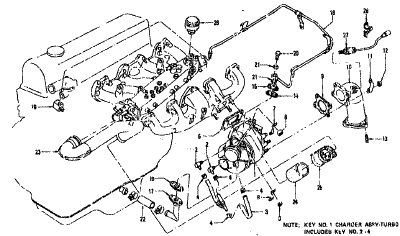
L28ET Turbo (Click to expand)
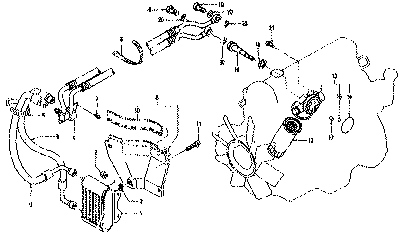
Oil Cooler (Click to expand)
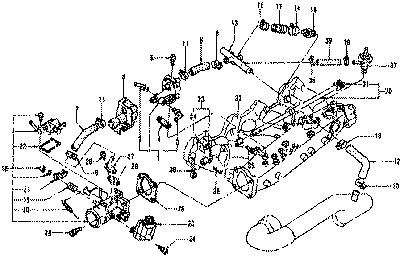
Intake Manifold (Click to expand)

EGR Area (Click to expand)
Garrett Air Research T3 Turbo
A stock 82 ZXT has Garrett Air Research T3 Turbo
installed.
- Normal (Stock) Boost is ~6psi
- Max Boost is 15psi
- Safe boost without intercooler is 10psi
- 60 comp trim and .63 turbine trim

T3 Turbocharger
The T3 turbocharger is designed for today's wide speed range medium displacement
engines requiring good low speed torque for responsive drivability and tailored
control of boost pressures from idle to rated speed. The T3 is engineered to
provide an economic performance boost for diesel and gasoline engines. The T3
will effectively cover most engine ratings from 175 to 250 hp, in
gasoline/petrol applications. Over 2,000,000 T3 turbochargers have been
produced.
T3 Specs
Weight 5.3 Kg
Compressor Diameter 51.4 mm
Turbine Diameter 53 mm
Bearing Span 31.9 mm
Moment of Inertia 2.1*10-5 Kg/m²
Oil Flow 1.2 l/m SAE 30 - 90ºC - 2.75 Bar
T3
Flow Maps
Garrett Air Research T3/T4 Hybrid Turbo
A T3/4 Hybrid Turbo has the Exhaust Side from a
Garrett T3 and the intake side from a T4

It is easy to see that the T4 is designed to flow
more air. (Opening has 1.48X bigger cross
sectional area)

Recommended upgrade for a stock L28ET engine
(280zxt) is T3/TO4B cost ~ $500
T3/T4
Turbo Install (great pics)
CheapTurbos.Com
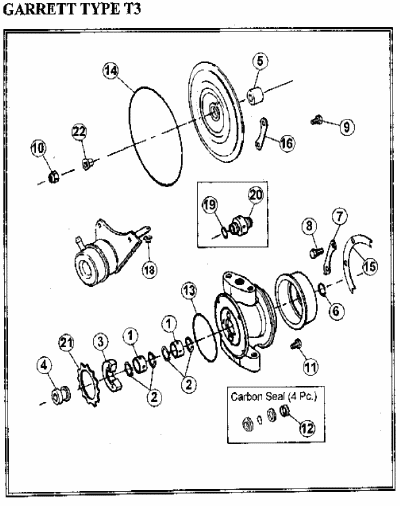
Z32
Turbo Page
























